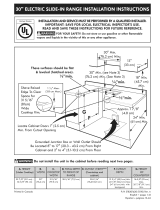
Notas importantes para el Mstalador
1.Leatodaslasinstruccionesantesdeinstalarlaestufa.
2.Retiretodomaterialdeempaquedehomoydela
gavetadeentibiadoantesdeconectarelsuministro
electricoalaestufa.
3.Observetodoc0digooreglamento.
4.Aseg0resededejarestasinstruccionesconelconsumidor
Nota importante para el consumidor
Mantenga estas instrucciones con el manual del usuario
para futuras referencias.
INSTRUCIONES DE
SEGURIDAD
IMPORTANTES
* Aseg_rese que su codna est_ instaJada y
conectada adecuadamente a tierra pot un
Jnstalador calificado o un t_cnico de servido.
* Esta cocina debe set conectada a tierra
eJ_ctricamente de acuerdo con los c6digos
locales, o de no existir, con la National Electrical
Code ANSI/NFPA No.70- _ltima edici6m
* La instalaciOn de el_ctrodom_sticos destinados para
casas (mOvil) deben conformarse con la Manufactured
Home Construction and Safety Standard, titulo 24CFR,
parte 3280 [antiguamente la Federal Standard for
Mobile Home Construction and Safety, titulo 24, HUD
(parte 280)] o cuando este c0digo no se aplica, la
Standard for Manufactured Home Installation 1982
(Manufactured Home sites, communities and setups) ;
ANSIZ225.1/NFPA 501A- 01tima ediciOn o con codigos
locales.
* Aseg_rese que el tapis de pared alrededor de la
cocina pueda resistir el caJor generado por Ja
estufa.
* Antes de instalar la estufa en una &tea cubierta de
Jinoleo o cualquier otto revestidor de piso
sint_tico, asegQrese que _ste pueda resistir aJ
menos 90°F sobre la temperatura de la pieza sin
encogerse, Jadearse o descoJorse. No instale la
* Todas las
cocinas
pueden
inclinarse.
* Esto puede
provocar
lesiones
personales
* Instale el
dispositivo
anti-inclinacion
que vienecon
la cocina.
_d ara
e
inclination de la cocina,
esta debe estar ajustada
correctamente con las
fijaciones anti inclinacion
que vienen con la cocina.
Paraverificar si las
fijaciones estan instaladas
adecuadamente, agarre la
parte superior del borde
_osterior de la cocina y
inclinela hacia adelante
cuidadosamente para
asegurar que la cocina esta
sujetada.
estufa encima de una alfombra a menos que coloque
una plata de aislamineto o una plancha de 1/4" de
madera entre la cocina y el alfombrado.
Nunca deje a los niffos solos o sin
cuidado en el area donde el el_ctrodom_stico est&
en uso. A medida que los niF/os crezcan, enseneles el
uso adecuado de los elOctrodomOsticos.Nunca deje la
puerta del homo abierta cuando la estufa est_ sin
supervisi6n.
V_ Pisar, apoyarse o sentarse en las
puertas o los cajones de la estufa pueden causar
graves herridas y tambi_n daffar la estufa.
* No coloque cosas que atraigan a los niffos sobre
los gabinetes encima de la estufa. Los ninos
podrian sufrir quemaduras tratando de alcanzarlos.
, Para evitar riesgos de quemaduras o incendios a[
tocar superficies caJientes, se deben evitar los
armarios sobre la superficie de los quemadores. Si
existe un armario, se pueden reducir los riesgos
instalando una campana que se extienda
horizontalmente en un minimo de 5" por sobre la
parte inferior de los armarios.
* No use el horno como espacio de almacenamiento.
Esto crea una situaci0n muy peligrosa.
* Nunca use su estufa para calentar la pieza. El uso
prolongado de la cocina sin ventilaci0n adecuada
puede ser peligroso.
* No guarde o use gasolina u otros vapores
inflamables y liquidos cerca de _ste o cualquier
otro el_ctrodom_stico. Esto podria causar una
explosion o un incendio.
* Vuelva a programar todos los controles a la
posiciOn "off" (apagado) despu_s de haber
utilizado el conteo contador autom&tico.
PARA LOS MODELOS CON AUTO-LIMPIEZA:
* Retire el rostisador, la comida y otros utensilios
antes de auto-limpiar el horno. Limpie todo exceso
de derrames. Siga las instrucciones para la pre-
limpieza en el Manual del usuario.
Estuche de cable del suministro
el ctrico
El utilisador es responsable de la conexi0n del cable del
suministro elOctrico al bloque de conexiOn situado detras
del panel de acceso.
El electrodom_stico se puede conectar a traves de un
cableado permanente "cableado duro"; cable de cobre
blindado armado o cable no-metalico flexible (cuando el
codigo local Io permite) o por medio de un kit de cable de
alimentacion. Vea la grafica (en la pagina siguiente) para
encontrar el tamaho minimo del cable a utilizarse (el listado
general de la UL, codigo local puede diferenciar).
16
























